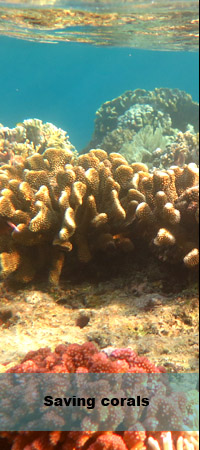|
Shallow water corals like the staghorn coral (Acropora cervicornis) have suffered unprecedented declines in the last 40 years. Staghorn coral used to be a dominant coral on Caribbean reefs. Beginning in the 1980s, the staghorn coral population declined 97 percent due to the white band disease (killing the coral’s tissues), lack of sea urchins (Diadema antillarum), and overfishing.
Staghorn coral is found typically in clear, shallow water (4 to 18 meters) on coral reefs throughout the Bahamas, Florida, and the Caribbean. Staghorn coral reaches reproductive maturity at about 20 cm tall. It reproduces once per year after the full moon in late summer by releasing eggs and sperm into the water column. Fertilized eggs develop into larvae that settle on hard surfaces and form new colonies. It can also form new colonies when broken pieces, called fragments, re-attach to hard surfaces. A broken-off branch (i.e., fragment) may land close to the original colony or be moved a short distance by waves. If the location is favorable, fragments grow into a new colony, expanding into and occupying additional area.

Images: Morphology of staghorn coral.
Staghorn coral is one of the fastest growing corals, when healthy, it can grow up to 10 cm in branch length per year with a range from 4 to 11 cm per year. This coral is highly dependent on sunlight for nourishment and it is the principal contributor to reef accretion in the Caribbean.
Coral reefs have suffered global declines due to climate change, coral bleaching, overfishing, pollution, habitat destruction, disease, and other anthropogenic factors. These declines have been particularly dramatic on Caribbean reefs due to historical overfishing, the mass mortality of an important sea urchin, and the unprecedented decline of Acropora corals due to white-band disease.
Staghorn coral is listed as Critically Endangered and there has been an 80-98% loss of individuals in parts of the Caribbean region since the 1980's. Declines on the order of 97% have been reported in the Florida Keys, Jamaica, Dry Tortugas, Belize and St Croix and Puerto Rico. The current situation is very serious and the fate of the staghorn is on our hands now.
The good news is that there have been some signs of recovery in some parts of its historical range and we can help the endangered staghorn to recover throughout its range. By reducing stressors (e.g., overfishing, pollution, coral bleaching) that contribute to its decline, then population of staghorn corals can be healthy again. As a result, a significant population growth and recovery can occur. At the same time, outplanting staghorn coral protects against local extinction and helps to maintain genetic diversity in the wild.

Endangered Species International is a U.S.-based, international organization, and a nonprofit, tax-exempt corporation under Section 501(c)(3) of the U.S. Internal Revenue Code. Your donations are tax deductible under U.S. laws.
|











